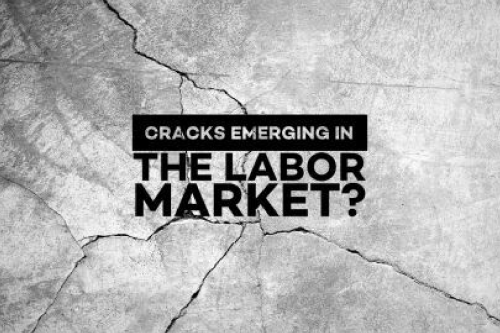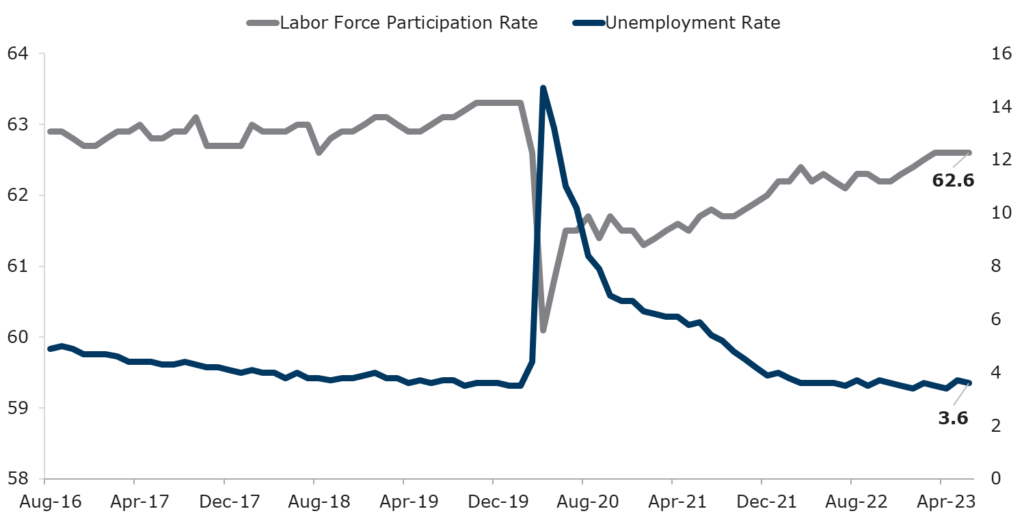
July 2023 Economic Review
As we enter the second half of the year, stubbornly persistent core inflation and surprising economic resilience remain major themes to the U.S. economic outlook. Six months into the year, the much-predicted recession has yet to materialize as the continued buoyancy of labor markets has helped to buffer the combined effects of fading fiscal stimulus and materially higher interest rates. To be sure, the labor market has been a solid pillar over the past year with an average of 316K jobs added per month and an unemployment rate that has remained in a historically low range of between 3.4% and 3.7%. While these conditions have served to underpin economic activity, a closer examination suggests that cracks are beginning to emerge in the labor market.
The pace of job creation slowed more than anticipated in June with nonfarm payrolls rising a less-than-expected 209K for the month. While a commendable gain, the June print was the weakest in 2 ½ years and marks the first time in 15 months that nonfarm payrolls have come in below Bloomberg consensus estimates. Moreover, a combined downward revision of -110K to the prior two months brings the four-month average pace of job growth down to 237K per month, its slowest pace since July 2020.
Cracks beneath the surface are emerging in other labor market data as well. Weekly initial claims for unemployment have been rising steadily throughout the year, averaging 242K per week in the second quarter compared to an average of 220K last quarter and 213K in 2022. In addition, average weekly hours worked continue to trend notably lower with the four-week average falling to its lowest level since April 2020. In its most recent release, the Job Opening and Labor Turnover (JOLTs) survey showed that the number of job openings, while still ample, continued to trend lower falling to 9.8 million in May from 10.3 million the month prior. Similarly, the so-called quits rate, which measures voluntary employee resignations and is generally perceived as an indicator of labor confidence, ticked higher in May but remains in a persistent downtrend approaching pre-pandemic levels. Data from the JOLTs survey is consistent with deteriorating sentiment in the Conference Board’s Consumer Confidence survey that shows further worsening in the share of individuals reporting jobs as plentiful vs. hard to get.
Despite these signs that tighter monetary conditions are beginning to weigh on the labor market, wage growth continues to run hotter than the Fed would like with average hourly earnings rising at an annual rate of 4.4% through June. While the recent pause and slowing in the pace of rate hikes is an acknowledgment that labor conditions are normalizing, the Fed’s forward guidance continues to emphasize that more work is necessary before declaring victory over inflation. Accordingly, we anticipate another 25-basis point rate hike at the Fed’s July 25-26th FOMC meeting with future policy decisions becoming notably more data dependent. Conditions in the labor market will remain closely watched by both policy makers and market participants alike for clues regarding future economic performance and interest rate policy.

Current Economic Releases |
|||
| Data | Period | Value | |
| GDP QoQ | Q1 ’23 | 2.00% | |
| US Unemployment | Jun ’23 | 3.60% | |
| ISM Manufacturing | Jun ’23 | 46.0 | |
| PPI YoY | Jun ’23 | 0.10% | |
| CPI YoY | Jun ’23 | 3.00% | |
| Fed Funds Target | Jul 14, 2023 | 5.00% – 5.25% | |
Treasury Yields |
|||
| Maturity | 7/14/23 | 6/21/23 | CHANGE |
| 3-Month | 5.234% | 5.276% | -0.042% |
| 6-Month | 5.472% | 5.395% | 0.077% |
| 1-Year | 5.291% | 5.237% | 0.054% |
| 2-Year | 4.702% | 4.715% | -0.013% |
| 3-Year | 4.312% | 4.294% | 0.018% |
| 5-Year | 4.000% | 3.957% | 0.043% |
| 10-Year | 3.797% | 3.719% | 0.078% |
| 30-Year | 3.910% | 3.807% | 0.103% |
Agency Yields |
|||
| Maturity | 7/14/23 | 6/21/23 | CHANGE |
| 3-Month | 5.518% | 5.607% | -0.088% |
| 6-Month | 5.440% | 5.452% | -0.012% |
| 1-Year | 5.265% | 5.301% | -0.036% |
| 2-Year | 4.713% | 4.659% | 0.054% |
| 3-Year | 4.356% | 4.202% | 0.155% |
| 5-Year | 4.030% | 3.853% | 0.177% |
| 6-Month | 5.700% | 5.640% | 0.060% |
| 9-Month | 5.780% | 5.760% | 0.020% |
Source: Bloomberg. Data as of July 14, 2023. Data unaudited. Many factors affect performance including changes in market conditions and interest rates and in response to other economic, political, or financial developments. Investment involves risk including the possible loss of principal. No assurance can be given that the performance objectives of a given strategy will be achieved. All comments and discussions presented are purely based on opinion and assumptions, not fact. These assumptions may or may not be correct based on foreseen and unforeseen events. The information presented should not be used in making any investment decisions. This material is not a recommendation to buy, sell, implement, or change any securities or investment strategy, function, or process. Any financial and/or investment decision should be made only after considerable research, consideration, and involvement with an experienced professional engaged for the specific purpose. Past performance is not an indication of future performance. Any financial and/or investment decision may incur losses.
